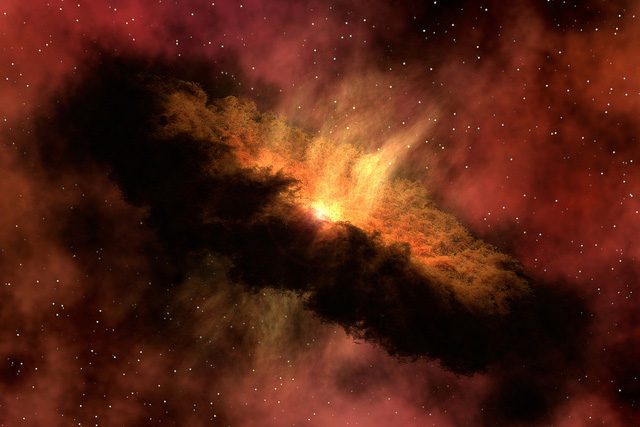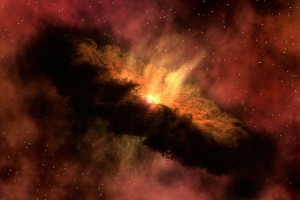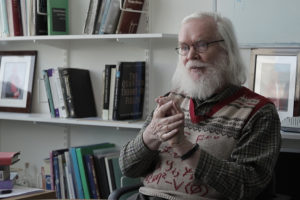Protoplanetary Disk Structures
Astronomer Hauyu Baobab Liu on luminous stars, accretion of molecular gas, and the evolution of planetary syst...

Over the last 2-3 decades, people who have been studying the formation of the solar-like system have reached a consensus about the overall evolutionary picture, which is well elaborated in a famous review paper of Dr. Frank Shu, published in 1987. Now people often conveniently call this model the Shu model. In the framework of the Shu model, the protoplanetary disk originates from a collapse of a dense molecular gas envelope (protostellar envelope hereafter). The host protostar located at the center of the protoplanetary disk grows via accretion material from the protoplanetary disk. Part of the dense gas and dust in the protoplanetary disk may condense into (proto)planets. The solar-like system eventually emerges after the protoplanetary disk is dispersed due to the interactions with protostellar wind, protostellar irradiation, and with planets.
A problem arises if one simply assumes the smooth and axisymmetric structures of the protostellar envelope and the protoplanetary disks. In such cases, the inferred protostellar accretion rate from the model will be several orders of magnitude higher than what is normally observed. This so-called “luminosity problem” was first noticed by Dr. Scott Kenyon in 1990. Later the luminosity problem was investigated very thoroughly by Dr. Neal Evans using the Spitzer Space Telescope surveys of the nearby star formation regions. A natural argument resolving this apparent paradox would be to say that protostars accrete episodically. A very active accreting phase may only occur in a very small fraction of the lifetime of a protostar and, therefore, can escape from most astronomical surveys. The short duration, extremely active accretion of some young stars, manifested by the sudden brightening in the optical and infrared wavelength bands, however, have been captured by some monitoring observations. For example, a type of young stellar object, namely the “FU Orionis objects”, also known as FUors, undergoes accretion outbursts during which the mass accretion rate of the star rapidly increases by a factor of 100~1000 and remains there for several decades or more.
The time-domain phenomenon – the episodic accretion – may be explained by the non-continuous feeding of the protoplanetary disk and thereby is linked to the spatially highly non-uniform structure of the protoplanetary disk. A series of numerical hydrodynamic simulations of Dr. Eduard Vorobyov and Dr. Shantanu Basu has suggested that, shortly after the formation of the protoplanetary disk, the rapid mass accumulation from the collapsing protostellar envelope into the newly formed disk can trigger complicated interaction of the disk material. In particular, the gravitational interaction may play a role in kneading disk material into dense gas fragments. These interactions also simultaneously create large spiral arm-like gas structures and gaseous arcs. When the dense gas fragments fall onto the protostars, they can lead to the sudden enhancement of the protostellar accretion rate (Figure 1). The protoplanetary disk is eventually stabilized via ejecting material which carries away the excess mass and angular momentum.

Figure 1. Numerical hydrodynamics simulations of protoplanetary disk formation from a collapsing protostellar envelope. (A) Simulated disk surface density. (B) The proto-stellar accretion rate over the time period of the simulation. Green boxes in panel A, and the time period bound by the green dashed lines in panel B, represent the proposed unstable evolutionary stage of young stellar objects.
The study by Baobab Liu’s group from the Academia Sinica Institute of Astronomy & Astrophysics was aimed at looking for the characteristic large spiral arm-like gas structures of the gaseous arcs via high angular resolution observations of the previously discovered FU Orionis objects. High angular resolution corresponds to the smallest angular scale that we can discern. Given an object with a certain physical size scale, the more distant it is, the smaller the angular scale it will occupy. At the time this research was carried out, the required sensitive high angular resolution imaging observations could only be achieved with the High Contrast Instrument for the Subaru Next Generation Adaptive Optics (HiCIAO) of the Subaru 8.2 m Telescope.

Figure 2. An overview of a massive stellar cluster-forming molecular cloud from numerical hydrodynamical simulations (courtesy of Dr. James Dale) and the context of the scale of the ALMA observations for the deeply embedded central few light-years region.
The detailed structures of the circumstellar material surrounding those accretion-outbursting young stars have been probed by performing very high angular resolution observations of near-infrared bands using the Subaru 8.2m Telescope. The experimental design was focused on the ongoing, very actively accreting young stellar objects since they are most likely to present complicated large-scale structures according to our theory. On the other hand, it remains difficult to probe disk structures at a high angular resolution if they are not illuminated with a very luminous, actively accreting protostar.
The observations resolved the expected 500~1000 AU scale spiral arm-like structures and arcs (Figure 3), which have never been seen in any previous observations. The commonly observed spiral arms and arcs are the smoking guns of the complicated interactions in the newly formed protoplanetary disk, which are linked to the episodic accretion or accretion outbursts of the young stellar objects. The morphology and spatial scales of these structures are very well consistent with the theoretical predictions, as seen in Figure 1A. The present finding does not only help to understand how protostars accumulate their final masses. In addition, the localized matter concentration in the non-smoothed, young protoplanetary disk structures further implies that planets can form in a much earlier evolutionary stage than what is expected from the standard planet formation scenario. It also permits higher than Jupiter mass planets to form at wider ranges of orbits, rather than being limited to form only in the densest inner protoplanetary disks. The results are, therefore, crucial for the self-consistent understanding of the formation and evolution of the solar-like system and, thereby, understanding the origin of human civilization.

Figure 3. Infrared images of accretion-outbursting young stellar objects, taken with the Subaru 8.2 meter telescope.
An immediate next step will be pursuing high angular resolution observation in the submillimeter and -centimeter frequency bands using the Atacama Large Millimeter Array (ALMA) and the Karl G. Jansky Very Large Array (JVLA). These observations can map the gas/dust density distribution in the forming protoplanetary disks more directly. The ALMA observations will additionally provide information on the gas motion. Presently, the number of observed samples is also very limited. The research will likely be expanded to observe younger stellar objects and also resolve the ones which are presently not very actively accreting. From the theoretical side, studies of astrochemistry in such systems with complicated interactions will guide future observations.
Edited by Polina Sandler

Astronomer Hauyu Baobab Liu on luminous stars, accretion of molecular gas, and the evolution of planetary syst...

Cosmologist Martin Rees on the history of space exploration, Sat Nav, and why robots are better than humans fo...

Physicist John Ellis on the history of particle physics, the properties of the Standard model particles and wh...